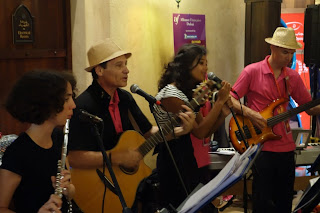I knew a good deal about Wales. Well, its history, at least. But it was at the last Feline Friends Kitten Ball, seated by chance at a table full of Welsh families, that I was first inspired to explore the culture of my Brythonic brethren. Months later, I made it the theme of my latest culinary adventure.
Tales of Wales
Native Welsh refer to their own land as Cymru, an endonym which was Latinized as Cambria, itself lent further to the name of the famous Cambrian geological period. The culinary symbol of Wales is the leek, which is used a lot in Welsh cooking (I bought more leek for this one meal than I normally buy in a year). The Welsh, blessed with abundant pastureland, are also known for their mutton/lamb, and love their cheese (known as caws in their language). Not many Welsh speak the Welsh native tongue Cymraeg today; Ioan Gruffudd is perhaps the most famous among those who can, and he even acted in Cymraeg TV series and films early in his career. So, to add a little Welsh touch to the lunch beyond the food, I found a number of Cymraeg songs to loop in a playlist, and constructed a modest leek centerpiece for the dining table.
Caws and Effect
For the starter, I was considering making Caws Pobi, or Welsh Rarebit, but decided against when I figured it had been done to death in pubs. Instead, I chose to make another cheese-based comfort snack called Selsig Morgannwg, or Glamorgan Sausage.
I had a tough time finding authentic Welsh Caerphilly cheese, so I settled for Wensleydale, which has a texture and taste similar to young Caerphilly. In one bowl, I mixed grated cheese with breadcrumbs and chopped leeks. In another, I whisked mustard, thyme and chopped parsley with egg yolk and pepper.
Combining these mixtures yielded a nice firm lump that can be split, rolled and flattened into sausage or patty shapes, and fried after dipping in the leftover egg white and breadcrumbs.
Although a subject of poverty humor much like the aforementioned Welsh Rarebit, it was actually very tasty, and it was a bitter fight to save a morsel for the most tardy of my guests.
Good Cawl
For the soup course, I went for the classic lamb stew that the Welsh know as Cawl.
I diced up a fresh bunch of root vegetables, including potato, parsnip, carrot and turnip, and (of course) chopped up some leek.
I threw all of these into a pot with mutton and lamb that I had been stewing for a few hours after browning with onion, along with bay leaves, thyme, rosemary and parsley. I also added some semolina to thicken.
A few minutes prior to serving, and while it was still piping hot, I tore up and stirred in a small head of Savoy cabbage. A hearty stew that is perhaps better suited to more wintry days, it nonetheless went down very well with the guests.
Ffowlyn Love with Chicken
For the main course, I prepared Ffowlyn Cymreig, or Welsh Chicken.
I diced turkey bacon, sliced carrots, and chopped leeks (yes, that again) while I browned pieces of chicken in a large pot.
I combined these and added a bit of milk and flour, followed by parsley, garlic powder, paprika and basil. I let all this stew for a couple of hours until the flavors had thoroughly penetrated the chicken and vegetables, and added chopped cabbage.
I cut trenchers out of country bread for each guest, onto which I ladled hot servings of now succulent and flavorful Welsh chicken.
Breaking Brith
For the dessert, I made two preparations, the first of which was a baked fruity cake/bread called Bara Brith - literally, Speckled Bread. It's almost like a Stollen, but darker and denser.
To start, I soaked dried fruit overnight in hot tea. To this, I added a mixture of caster sugar, egg and orange marmalade.
Adding self-raising flour and mixed spice resulted in thick batter, which was softened out with a splash of milk. After baking in a shallow tin, I glazed the top with honey.
These are usually served as a tea snack, slathered with butter. We just cut our dietary losses and had them plain.
Sweet Cake of Maen
The second dessert preparation was a batch of griddle cakes called Picau ar y Maen, or Bakestone Cakes.
It was a fairly simple combination of butter rubbed into flour, to which raisins, egg and caster sugar are added. I flattened small lumps of this mixture onto an hot iron pan that had been greased with a little butter, giving each side three or so minutes.
By this point, we were quite stuffed, but we all enjoyed our sample-sized picau, and our Cymric gastronomical experience.






















































